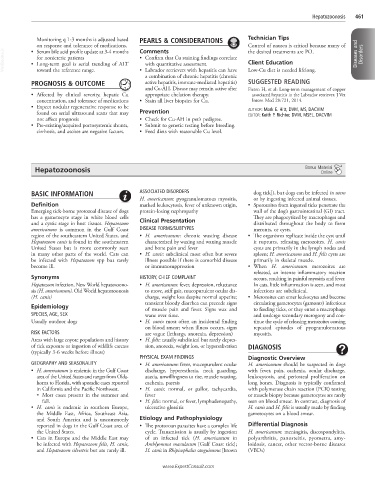Page 939 - Cote clinical veterinary advisor dogs and cats 4th
P. 939
Hepatozoonosis 461
Monitoring q 1-3 months is adjusted based PEARLS & CONSIDERATIONS Technician Tips
on response and tolerance of medications. Comments Control of nausea is critical because many of
VetBooks.ir • Long-term goal is serial trending of ALT • Confirm that Cu staining findings correlate Client Education Diseases and Disorders
the desired treatments are PO.
• Serum bile acid profile update at 3-4 months
for nonicteric patients
with quantitative assessment.
toward the reference range.
• Labrador retrievers with hepatitis can have
a combination of chronic hepatitis (chronic Low-Cu diet is needed lifelong.
PROGNOSIS & OUTCOME active hepatitis, immune-mediated hepatitis) SUGGESTED READING
and Cu-AH. Disease may remain active after Fieten H, et al: Long-term management of copper
• Affected by clinical severity, hepatic Cu appropriate chelation therapy. associated hepatitis in the Labrador retriever. J Vet
concentration, and tolerance of medications • Stain all liver biopsies for Cu. Intern Med 28:721, 2014.
• Expect nodular regenerative response to be AUTHOR: Mark E. Hitt, DVM, MS, DACVIM
found on serial ultrasound scans that may Prevention EDITOR: Keith P. Richter, DVM, MSEL, DACVIM
not affect prognosis • Check for Cu-AH in pet’s pedigree.
• Pre-existing/acquired portosystemic shunts, • Submit to genetic testing before breeding.
cirrhosis, and ascites are negative factors. • Feed diets with reasonable Cu level.
Hepatozoonosis Bonus Material
Online
BASIC INFORMATION ASSOCIATED DISORDERS dog tick]), but dogs can be infected in utero
H. americanum: pyogranulomatous myositis, or by ingesting infected animal tissues.
Definition marked leukocytosis, fever of unknown origin, • Sporozoites from ingested ticks penetrate the
Emerging tick-borne protozoal disease of dogs protein-losing nephropathy wall of the dog’s gastrointestinal (GI) tract.
has a gametocyte stage in white blood cells Clinical Presentation They are phagocytized by macrophages and
and a cystic stage in host tissues. Hepatozoon distributed throughout the body to form
americanum is common in the Gulf Coast DISEASE FORMS/SUBTYPES meronts, or cysts.
region of the southeastern United States, and • H. americanum: chronic wasting disease • The organisms replicate inside the cyst until
Hepatozoon canis is found in the southeastern characterized by waxing and waning muscle it ruptures, releasing merozoites. H. canis
United States but is more commonly seen and bone pain and fever cysts are primarily in the lymph nodes and
in many other parts of the world. Cats can • H. canis: subclinical most often but severe spleen; H. americanum and H. felis cysts are
be infected with Hepatozoon spp but rarely illness possible if there is comorbid disease primarily in skeletal muscle.
become ill. or immunosuppression • When H. americanum merozoites are
released, an intense inflammatory reaction
Synonyms HISTORY, CHIEF COMPLAINT occurs, resulting in painful myositis and fever.
Hepatozoon infection, New World hepatozoono- • H. americanum: fever, depression, reluctance In cats, little inflammation is seen, and most
sis (H. americanum), Old World hepatozoonosis to move, stiff gait, mucopurulent ocular dis- infections are subclinical.
(H. canis) charge, weight loss despite normal appetite; • Merozoites can enter leukocytes and become
transient bloody diarrhea can precede signs circulating gametocytes (gamonts) infectious
Epidemiology of muscle pain and fever. Signs wax and to feeding ticks, or they enter a macrophage
SPECIES, AGE, SEX wane over time. and undergo secondary merogony and con-
Usually outdoor dogs • H. canis: most often an incidental finding tinue the cycle of releasing merozoites causing
on blood smear; when illness occurs, signs repeated episodes of pyogranulomatous
RISK FACTORS are vague (lethargy, anorexia, depression) myositis.
Areas with large coyote populations and history • H. felis: usually subclinical but rarely depres-
of tick exposure or ingestion of wildlife carcass sion, anorexia, weight loss, or hypersalivation DIAGNOSIS
(typically 3-6 weeks before illness)
PHYSICAL EXAM FINDINGS Diagnostic Overview
GEOGRAPHY AND SEASONALITY • H. americanum: fever, mucopurulent ocular H. americanum should be suspected in dogs
• H. americanum is endemic in the Gulf Coast discharge, hyperesthesia, neck guarding, with fever, pain, cachexia, ocular discharge,
area of the United States and ranges from Okla- ataxia, unwillingness to rise, muscle wasting, leukocytosis, and periosteal proliferation on
homa to Florida, with sporadic cases reported cachexia, paresis long bones. Diagnosis is typically confirmed
in California and the Pacific Northwest. • H. canis: normal, or pallor, tachycardia, with polymerase chain reaction (PCR) testing
○ Most cases present in the summer and fever or muscle biopsy because gametocytes are rarely
fall. • H. felis: normal, or fever, lymphadenopathy, seen on blood smear. In contrast, diagnosis of
• H. canis is endemic in southern Europe, ulcerative glossitis H. canis and H. felis is usually made by finding
the Middle East, Africa, Southeast Asia, gametocytes on a blood smear.
and South America and is uncommonly Etiology and Pathophysiology
reported in dogs in the Gulf Coast area of • The protozoan parasites have a complex life Differential Diagnosis
the United States. cycle. Transmission is usually by ingestion H. americanum: meningitis, discospondylitis,
• Cats in Europe and the Middle East may of an infected tick (H. americanum in polyarthritis, panosteitis, pyometra, amy-
be infected with Hepatozoon felis, H. canis, Amblyomma maculatum [Gulf Coast tick]; loidosis, cancer, other vector-borne diseases
and Hepatozoon silvestris but are rarely ill. H. canis in Rhipicephalus sanguineous [brown (VBDs)
www.ExpertConsult.com

